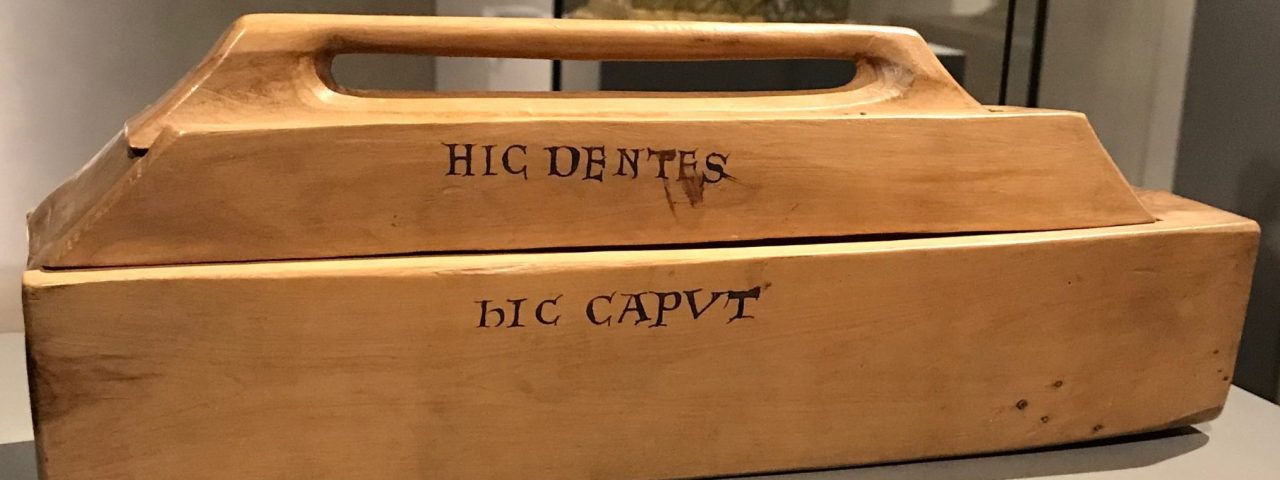Rethinking the Late Medieval Relic (c. 1200–1550)
Academy Research Fellowship (349210), funded by the Academy of Finland
PI Marika Räsänen
Through religious relics people encountered God’s touch on earth. Still today the divine power of a relic makes it a potentially desirable and inseparable part of people’s life in the Catholic world. Yet, the notion and the history of the relic is not straightforward. The Late Middle Ages proved to be a crucial era with regard to changing perception of relics. The society that sought devotional interplay with the holy was in flux. New social groups were emerging and they too sought to influence the religious domain. They were helped by new kinds of religious orders, Mendicants, and the Order of Preachers in particular. The change was also tangible: Crusading armies for example brought an enormous quantity of precious Christian relics back as booty when they returned to the Latin West. Doctrinal misuse of relics was becoming common, and the large number of new relics aggravated the situation. All this shook relic doctrine.
For the first time, the gap between written canon law and everyday practices concerning relics widened to such an extent that the situation required an explicit response from the church authorities. Through the declarations of the Lateran Council (1215), Pope Innocent III sought to monopolize the definition and use of relics for the Church. While some obscure or dubious relic practices were aimed to extirpate, popes encouraged some others by granting indulgences. Relic cults of religious professionals, allegedly controllable (for example, St. Dominic Guzman, founder of the Order of Preachers, d. 1221) achieved easily the Popes’ acceptance. The proliferation of relics as well as their varied uses continued until the Council of Trent (1545–63), which aimed to solve the problem, with little obvious success.
Scholars have assumed that in consequence of several time-related factors including strict limits set on relics by the Catholic Church, profound societal changes, and decisive historical events, the role and importance of holy remains of saints diminished radically both in political discourse and in people’s lives in Western Europe. The project Rethinking the Late Medieval Relic challenges these older interpretations arguing that, rather than curtailing the importance of relics, this tumultuous era engendered new pluralism in holy matter just as the Church attempted to restrict their role. Eventually, the forms of existence of relics were challenged in many ways, but the legal basis of the relic’s raison d’être was not at risk: the relic was a sign of the unification of the earthly and heavenly worlds, a testimony of Christ’s resurrection and a promise of the resurrection of the body at the end of time. People reacted to the extreme pressures working against the established concepts, beliefs and uses of the holy item and embraced new items as relics and adopted new relic practices for contacting God and saints. In consequence, my study will highlight the significance of materiality and blurring boundaries of everyday items and devotional objects in the late medieval lived religion on one hand and abstract relic-ness on the other, studying the potentiality of imagination in devotional practices connected to sainthood and supernatural.
The specific context of the study:
The project focuses especially on the late medieval Dominican culture. Dominican culture (broadly speaking and including also lay-people under their influence) encompasses particularly well different phenomena, typical to the late Middle Ages, which had their assumed effects on defining, understanding, and utilizing relics. Even the existence of the Order of Preachers (commonly known as Dominicans) was one symptom or result of the late medieval societal changes. Prerequisite for its success was in mutual interconnection with the lay people, including spiritual guidance and practical aid. Often the friars represented the highest theological knowledge of relic doctrine and they produced a significant quantity of different kinds of manuals and documents, relevant to this project. Their theological, pastoral, political, and sometimes even economic know-how made them counselors of popes and bishops as well as kings and princes. As a result, studying Dominican activity offers us more nuanced picture on those pressing factors against historically stabilized relic practices initiated first in high politico-theological level of the thirteenth century and diffused more broadly to the grass-ground level in fourteen and fifteen-centuries. Thus, focusing on the Dominican cultural milieu enables outlining the whole spectrum of the complex research question and helps to define vast source material, and at the same time, to ensure the context related deep, qualitative analysis.
Activities organized by the project
“Hagiography Afternoon”, in collaboration with the Turku Centre for Medieval and Early Modern, University of Turku, 17. September 2024
Seminar “Les reliques à la fin du Moyen Âge: un objet à re-penser”, jointly with Prof. Cécile Caby, Université de Sorbonne, Paris, 27. March 2024
Concert at the Turku Cathedral, 28 Jan 2024 Thomas ab Italia, tibi Tolosa -konsertti
Round table discussion, University of Turku, 8 Dec 2023 Marvels of the Premodern Forest
Writing workshop with the TiTaRa-project, University of Turku, 10. Nov 2023 https://koneensaatio.fi/hanke/titara/
International Symposium “City of Trees” at the Finnish Institute of Rome, 22 Nov 2022 https://irfrome.org/en/21-11-international-seminar-city-of-trees/
***
Cover image: Godehard Shrine, produced in Hildesheim, ca 1132, Hildesheim Cathedral Museum
Photo credits: Marika Räsänen
